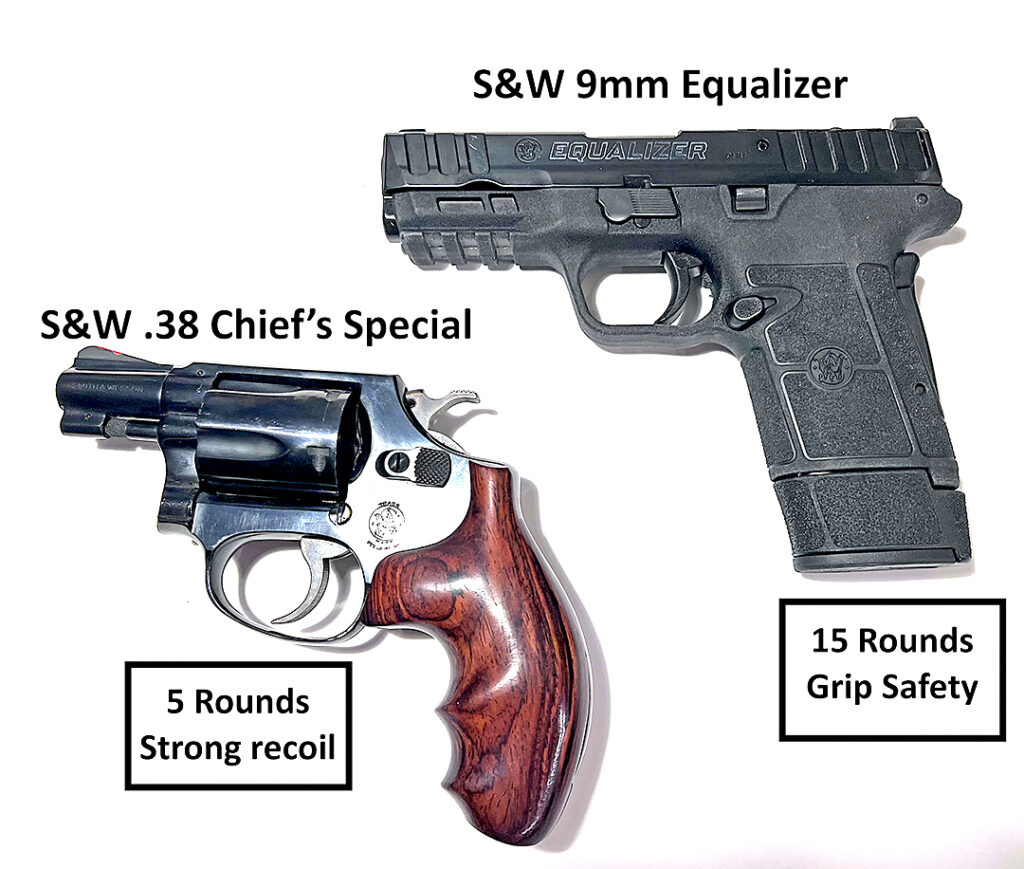First guns for Christmas


On Saturday, we were glued to the television watching FSU Seminoles playing the Florida Gators. In The Swamp, no less.
Since I graduated from FSU, you know who I wanted to win. Joe used to live in mid-Florida. He says he roots for FSU, but I think he has a sneaking preference for those Gators. We both knew we were right (and I won’t rub it in by reminding you who did win…).
Doesn’t matter. We all have differences of opinion. Take handguns.
After I met Joe, a man was at a dinner party with us. He asked me: “Did you teach Joe everything he knows about guns?”
He asked this with a straight face, so I flattered myself that this was an honest question.
“Well, no,” I had to answer. “I’ve been shooting for 5 years. Joe’s shot with some of the men in his family since he was a boy and he shot in the Navy. But that doesn’t mean I don’t have some valid opinions. And sometimes Joe is just plain wrong, wrong, wrong.”
That was 8 years ago. Know what? I still consider some of Joe’s assertions to be outdated.
Let’s talk about .38 revolvers. A lot of guys buy them for their women because they “will never jam,” and they have great “take down power.” Even Joe, knowing how I feel about those .38s says he likes them because yes, they are reliable. He likes the snub-nose version, too, saying it is very accurate. And last, he says that for him, it is easily controllable and he compares the recoil to that of a 9mm handgun.
Do you believe such balderdash? We’ll start with the phrase “never jam.” The .38 has a cylinder that turns. C’mon. Anything that moves can be made not to move. For instance, if a bit of chewing gum wrapper or other debris insinuates itself somewhere around the cylinder, it can stop the cylinder from rotating freely. Naturally, if the cylinder only moves partway, individual chambers won’t align with the barrel. Age, grease gunk, debris… All these things can wreak havoc with the timing of the cylinder’s turn. Good luck making that shot!
And the .38 is controllable? Sure. It’s controllable for Joe. He has huge bones and lots of military training. But you take Newbie, a person with arthritis, a small-boned or a mature person and have any one of them shoot the Chief’s Special .38. Warn them, of course, that they’ll have to have a very firm grip and be ready for a harsh recoil.
After that shot, put a 9mm Smith & Wesson Equalizer in their hands and ask them to shoot.
They’ll look like they just struck gold. Sure, Joe’s size and training make the .38 easy to shoot. But Newbie? Mature person? Small person?
No. They’ll take the 9mm Equalizer in a Wakulla minute. It has a ton less recoil and a nice, soft shoot.
And yes, both handguns can foul if dirty with debris. The fix? Keep your guns clean and in good holsters.
Do .38s have more take down power? Well, that’s debatable. Yes, some people believe the .38 has more take down power than a 9mm. But which gun is really most effective?
You get 5 shots with that .38 Chief’s Special. And how many shots in the magazine of the Equalizer? Let’s see. The gun comes with a magazine that holds 10, another magazine that holds 13 and one that holds 15 rounds. If Mr. Bad is coming at you, and you aim and miss a couple shots, wouldn’t you prefer knowing you have 15 rounds to protect your family? 15 rounds is take down power to me.
Never jam? Take down power? Skip the .38 and go for the 9mm handgun.
Next, Joe prefers 1911 guns. The famous John Moses Browning designed this pistol. When? In 1911. That’s a long time ago. The 1911 was then a .45-caliber gun and is still known for its single-action trigger, safety mounted on the frame, smooth and crisp trigger, short recoil system and single stack magazine, usually holding 8 to 10 rounds. It is made of metal and is a hammer gun.
Let’s talk about that safety on the hammer fired 1911s: Joe was taught in the Navy. While pulling the gun from its holster, Joe’s thumb slides down the frame, disengaging the safety. He thinks anyone can learn how to put disengaging the safety into their muscle memory.
No. Just no.
You take a mature lady who has made a dozen trips to the range with her gun. Yes, she’s pretty familiar with it now. But when Mr. Bad breaks down her door, is she going to remember to flip down the safety? No.
Then I ask Joe what is the reasoning for a safety.
He says that back in the military, on a 1911 hammer fired gun, the safety helps avoiding accidental discharge when taking in and out of the holster. It avoids accidental discharge when dropped. A safety prevents accidental discharge when climbing in and out of the car.
While all that may be true, striker-fired guns have safeties too. However, they have other types of safeties. For instance, you might have a grip safety or a couple kinds of trigger safeties. Your striker-fired gun with a grip safety will only shoot if you have a firm hold on the grip. This means a really firm grip. Crawling out of your car or having something lean on the grip in your purse won’t set it off.
A trigger safety is an additional lever beside the trigger. Unless both the trigger safety and the trigger are depressed together, that gun won’t fire.
Another trigger safety is a long or hard trigger pull. If the trigger pull is long, a short tug will not be sufficient to let the gun fire. If the trigger has a hard pull, again, pulling that trigger will have to be an intentional move. It can’t happen accidentally.
Grip and trigger safeties mean that if you ever have to shoot in self-defense, you will not have to remember to disengage the safety. Safeties? I like those built-in safeties you find on striker fired guns.
Another point of friendly disagreement is the UpLula. The UpLula makes loading a magazine easy. Joe says I should learn to load with my thumbs.
“Back in the Navy,” Joe says, “Master Gunner’s Mate Extra Strong Thumbs taught us to load the magazines by ourselves. No cheating assists.”
Well, back then in the Navy, the guys learning were young and strong. I don’t have any need to prove myself, and am only too happy to use an UpLula. Somehow, the UpLula is able to push against the magazine’s spring so you can drop in your rounds easily. Push in those rounds yourself? Heck, you might break a nail. Do it the easy way with your UpLula.
I maintain that some guns, particularly 1911s, are difficult to break down.
“As often as you take down your gun, it’s meaningless to use this as criteria for choosing a handgun,” Joe says.
Well, he says that now, but when I first began shooting, he had me cleaning my gun after each range session.
Have you ever tried to take down a 45 caliber 1911? It comes with a special wrench you put at the muzzle of the gun. It takes a whole lot of oomph to turn that thing. And that’s just the beginning.
My nice striker fired guns have takedown levers on the frames. You lock back the slide, push the lever down and guide the slide off the frame. Doesn’t require strength or any special tool. Easy. I like easy.
So, Joe is partial to 1911 hammer fired guns for their superior triggers, accuracy, and reliability. I prefer striker fired guns for their simplicity as well as their accuracy and reliability. That’s what I want in a gun.
“Do you really?” asks Joe. “What about your Sig Sauer P238? Seems to me the P238 is a miniature 1911 hammer fired gun? H’m?”
Okay. He’s got me there. I do like this tiny Sig that shoots accurately and fits in my purse.
“Well, yes, but…” I sputter. “What about your Sig Sauer P320? It’s a striker fired gun and you really like it!”
What can I say? Joe mostly prefers hammer fired guns and the Gators. I mostly prefer striker fired guns and the Seminoles.
We’re both right.
Marj Law is the former director of Keep Wakulla County Beautiful who has become an avid shooter in retirement.

